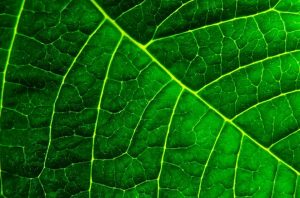 In case this is news, most plants grow poorly in the dark. Their green cells, colored by a pigment called chlorophyll, use the energy in light to combine the element carbon (C) found in dead stuff, and water (H2O), to make glucose, a sugar that powers cell reproduction which is how plants grow. Voila, photosynthesis. At night our green friends rest.
In case this is news, most plants grow poorly in the dark. Their green cells, colored by a pigment called chlorophyll, use the energy in light to combine the element carbon (C) found in dead stuff, and water (H2O), to make glucose, a sugar that powers cell reproduction which is how plants grow. Voila, photosynthesis. At night our green friends rest.
Here’s how a person in a white lab coat might describe photosynthesis:
6C + 12H2O + sunlight = C6H12O6 + 6O + 6H2O
Confused? In plain English that’s 6 parts of carbon plus 12 parts of water plus sunlight. At the equal sign things bubble and fizzle until a sugar molecule pops out–a carbohydrate, the C6 H12 O6 –plus some leftover oxygen gas and water. If the plant doesn’t use all its light energy, it stores the excess in the sugar molecule.
I can’t decide if that makes me feel smart or fat.
Almost all living organisms get food directly or indirectly from the sugars formed by photosynthesis, so even if you live on T-bone steaks your main dish ate something green back in the pasture.
Common edible plant life like the stuff in your garden requires a lot of intense light, 6-8 hours minimum full sun daily. Alaskans grow giant cabbages when the sun shines nonstop for 6 months, after which their gardens scream, “Lights out!”
Light Quality
Plant leaves and stems like bluish light while flowers like a red-to-blue combination. Some gardeners lay red plastic under their tomato plants to reflect that part of the color spectrum, and encourage flowering. Flowers, of course, make fruits. Stems, leaves, and roots are vegetables.
Light Intensity
The quantity of available light determines the amount of photosynthesis which powers growth. Remember, it’s easier to get sunburned at the equator than the North Pole, and plants can “grow like weeds” during a sunny summer.
Light Duration
Summer days are longer than other days of the year. The length of uninterrupted light every 24 hours is critical to photosynthesis, and the amount of uninterrupted dark every 24 hours is critical to flower production. Who knew? Short-day plants bloom in spring and fall when nights last 12 or more hours. Long-day plants bloom in summer when nights last less than 12 hours. Some “day-neutral” plants don’t fit these categories, they bloom when the spirit moves them.
"light" - Google News
May 30, 2020 at 09:54PM
https://ift.tt/2TR1uiI
Gardening: Photosynthesis - let there be light - The Cross Timbers Gazette
"light" - Google News
https://ift.tt/2Wm8QLw
https://ift.tt/2Stbv5k
Bagikan Berita Ini















0 Response to "Gardening: Photosynthesis - let there be light - The Cross Timbers Gazette"
Post a Comment